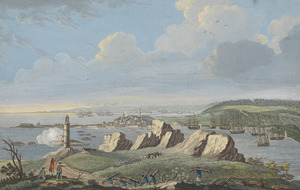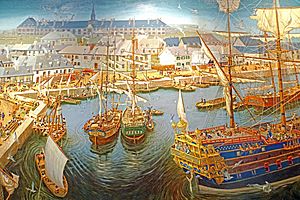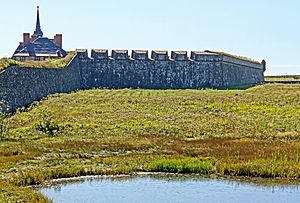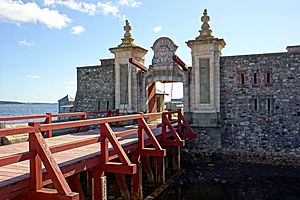Fortress of Louisbourg facts for kids
Quick facts for kids Fortress of Louisbourg |
|
|---|---|
| Native name French: Forteresse de Louisbourg |
|
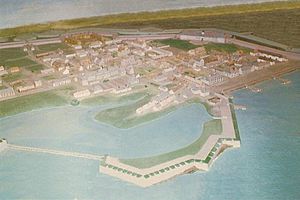
Diorama of the Fortress of Louisbourg in 1758
|
|
| Location | 259 Park Service Rd, Louisbourg, Nova Scotia, Canada B1C 2L2 |
| Built | 1713–1740 |
| Lua error in Module:Location_map at line 420: attempt to index field 'wikibase' (a nil value). | |
| Official name: Fortress of Louisbourg National Historic Site | |
| Designated: | 30 January 1920 |
The Fortress of Louisbourg (in French: Forteresse de Louisbourg) is a special place in Canada. It's a National Historic Site located in Louisbourg, on Cape Breton Island, Nova Scotia. Here, you can see a partially rebuilt 18th-century French fortress.
This fortress was very important in the battles between the French and the British for control of what is now Canada. Two big battles, especially one in 1758, changed history.
The first settlement started in 1713 and was called Havre à l'Anglois. It grew from a fishing village into a busy trading port and a strong fortress. Walls were built around the town mostly between 1720 and 1740. By the 1740s, Louisbourg, named after King Louis XIV of France, was one of the biggest and most expensive European forts in North America.
However, the fortress had some weak points. It was built on low ground, and nearby hills could overlook it. Its defenses were strong against attacks from the sea, but weaker from the land. Also, it was very far from France or Quebec, making it hard to get help or supplies.
British colonists captured Louisbourg in 1745. It became a key part of the peace talks that ended the War of the Austrian Succession in 1748. The fortress was given back to the French in exchange for other towns. But in 1758, British forces captured it again during the Seven Years' War. After this, the British completely destroyed its walls and buildings. A British army stayed at Louisbourg until 1768.
In the 1960s and 1970s, parts of the fortress and town were rebuilt. Workers used some of the original stones. This project also created jobs for coal miners who were out of work. Today, Parks Canada runs the site as a living history museum. It's the largest reconstruction project of its kind in North America.
Contents
History of the Fortress
French people first settled on Île Royale (now Cape Breton Island) in the early 1600s. Before Louisbourg, there were French settlements in Acadia, like Port-Royal in what is now Nova Scotia.
A French settlement called Sainte Anne (now Englishtown) was built on Île Royale in 1629. It was called Fort Sainte Anne and lasted until 1641. A fur trading post was there from 1651 to 1659. But France focused more on its other colonies, like Canada (which included parts of modern-day Quebec and Ontario) and Louisiana.
The Treaty of Utrecht in 1713 gave Britain control of parts of Acadia and Newfoundland. But France kept control of Île Royale, Île Saint-Jean (now Prince Edward Island), Canada, and Louisiana. Île Royale was France's only territory directly on the Atlantic coast. It was important because it was close to rich fishing areas, like the Grand Banks of Newfoundland. It also helped protect the entrance to the Gulf of St. Lawrence.
In 1713, France started building a naval base at Port Dauphin, where Fort Sainte-Anne used to be. But the harbor froze in winter. So, the French chose a better, ice-free harbor on the southeastern part of Île Royale. This harbor became a winter home for French navy ships. They named it Havre Louisbourg after King Louis XIV.
First Big Battle: 1745
- Further information: Siege of Louisbourg (1745)

In 1745, forces from New England attacked the Fortress of Louisbourg. The British navy helped them. The New England attackers won, and the fortress surrendered on June 16, 1745.
The French tried to get the fortress back the next year. A large French expedition, led by Duc d'Anville, set out. But storms, sickness, and British naval attacks destroyed the expedition before it even reached Louisbourg.
Louisbourg Given Back
In 1748, the Treaty of Aix-la-Chapelle ended the War of the Austrian Succession. This treaty gave Louisbourg back to France. In return, Britain got back its trading post at Madras in India. The French government really wanted Louisbourg back because it was vital for their fishing industry in the area.
The New England forces left Louisbourg, taking with them a famous cross from the fortress chapel. This cross was found again much later in the Harvard University archives. Today, it is on loan to the Louisbourg historic site.
After giving up Louisbourg, Britain built its own fortified town in 1749. They named it Halifax. It quickly became the biggest British navy base on the Atlantic coast. Many British soldiers were stationed there.
Second Big Battle: 1758
- Further information: Siege of Louisbourg (1758)
By the 1750s, Britain's American colonies were expanding into lands claimed by France. French forces and their First Nations allies tried to block the colonists from moving west. This led to small fights that grew into the French and Indian War in 1754. By 1756, this conflict became the larger Seven Years' War, involving many powerful European countries.
In 1757, a large French navy stopped a British attack on Louisbourg. But the next year, the French navy wasn't strong enough. A large British force, led by Jeffrey Amherst, landed and started the 1758 Siege of Louisbourg. After six weeks, on July 26, 1758, the French surrendered.
The British then used Louisbourg as a starting point for their attack on Quebec in 1759. This led to the famous Battle of the Plains of Abraham.
In 1760, British engineers carefully destroyed the fortifications at Louisbourg. They wanted to make sure the French could never use the town and port again, even if the land was returned to France. The British kept soldiers at Louisbourg until 1768. Some of the stones from Louisbourg were sent to Halifax and later to Sydney, Nova Scotia, to be reused.
Governors of Louisbourg
Many governors led the Fortress of Louisbourg over the years:
- Philippe Pastour de Costebelle (1714-1717)
- Joseph de St. Ovide, Monbeton de Brouillan (1717-1739)
- Isaac-Louis de Forant (1739-1740)
- Jean-Baptiste Prévost du Quesnel (1740-1744)
- Louis Du Pont Duchambon de Vergor (acting, 1744-1745)
- Peter Warren (1745-1746)
- Charles Knowles (1746-1747)
- Peregrine Thomas Hopson (1747-1749)
- Charles des Herbiers de La Ralière (1749-1751)
- Jean-Louis de Raymond (1751-1753)
- Augustin de Boschenry de Drucour (1754-1758)
Louisbourg in the 20th Century
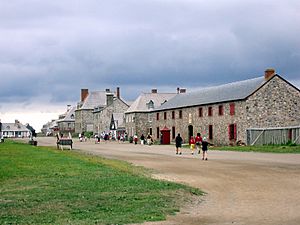
The site of the fortress became a National Historic Site in 1920. In 1961, the Canadian government began a huge project. They decided to rebuild one-quarter of the town and its fortifications. The goal was to show Louisbourg exactly as it looked in the 1740s.
This work needed many experts: archeologists, historians, engineers, and architects. Unemployed coal miners from industrial Cape Breton helped with the reconstruction. Many learned old French masonry (stone-building) techniques. They used many of the original stones when possible.
Today, the entire site, including the rebuilt quarter, is called the Fortress of Louisbourg National Historic Site of Canada. Parks Canada operates it. You can take guided or self-guided tours. You can also see demonstrations of 18th-century weapons, like muskets and cannons.
The fortress has helped the local town of Louisbourg a lot. It brings tourists and jobs, especially as the fishing industry has declined.
On May 5, 1995, Canada Post released a series of stamps called 'Fortress of Louisbourg'. These stamps celebrated several anniversaries related to the fortress's history.
The museum at the Fortress works with other Canadian museum organizations.
A Fortified Town
The Fortress of Louisbourg was the main city for the French colony of Île-Royale. It was built on the Atlantic coast of Cape Breton Island. The location was chosen because it was easy to defend. It protected against British ships trying to block or attack the St. Lawrence River. This river was the only way to get goods to French cities like Quebec and Montreal.
South of the fort, a natural reef helped protect it. A large island also provided a good spot for a cannon battery. These defenses forced British ships to enter the harbor through a narrow 500-foot channel. The fort was built to protect France's valuable North American fishing industry. It also guarded Quebec City from British invasions. Because of its strength, it was sometimes called the 'Gibraltar of the North'.
Louisbourg was also built to protect France's control over the Grand Banks of Newfoundland, one of the richest fishing areas in the world. When it was first settled, 116 men, 10 women, and 23 children lived in Louisbourg.
How Louisbourg Grew
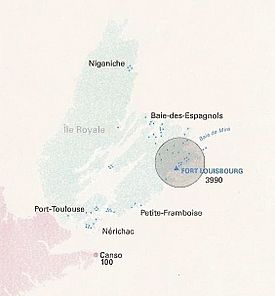
The population of Louisbourg grew quickly.
- In 1719, 823 people lived there.
- By 1726, the population was 1,296.
- In 1734, it reached 1,616.
- By 1752, Louisbourg had 4,174 people.
Even though smallpox affected the population in 1731 and 1732, Louisbourg continued to grow, especially its economy.
| Year | Inhabitants |
|---|---|
| 1719 | 823 |
| 1726 | 1296 |
| 1734 | 1616 |
| 1737 | 2023 |
| 1740 | 2500 |
| 1745 | 3000 |
| 1750 | 3990 |
| 1752 | 4174 |
Louisbourg's Economy
Louisbourg was a large city with a commercial area, homes, military zones, markets, inns, and pubs. It also had many skilled workers. For the French, it was the second most important stronghold and trading city in New France. Only Quebec was more important.
Unlike most other cities in New France, Louisbourg did not rely on farming. Louisbourg was a very popular port. It was the third busiest port in North America, after Boston and Philadelphia. It was also known for exporting fish and fish products, like cod-liver oil.
The North Atlantic fishing trade employed over ten thousand people. Louisbourg was seen as a "nursery for seamen" because so many sailors worked there. The fishing industry was more profitable for France than the fur trade. In 1731, Louisbourg fishermen exported 167,000 quintals (about 8,000 tons) of cod and 1,600 barrels of cod-liver oil. About 400 small fishing boats went out daily. Also, 60 to 70 larger schooners sailed from Louisbourg to catch fish further down the coast.
Louisbourg's success attracted ships from Europe, the West Indies, Quebec, Acadia, and New England.
Strong Fortifications
Louisbourg was famous for its strong walls, which took French builders 28 years to finish. The main engineer was Jean-Francois du Vergery de Verville. He chose Louisbourg because of its natural barriers. The fort cost France 30 million French livres (an old French currency). This was so much money that King Louis XV joked he should be able to see the fort's buildings from his palace in Versailles! The original budget was only four million livres.
Two and a half miles of wall surrounded the entire fort. On the western side, the walls were 30 feet high and 36 feet thick. They were protected by a wide ditch and ramparts (earth banks).
The city had four gates. The Dauphin Gate, which is rebuilt today, was the busiest. It led to the fishing areas and the main road inland. The Frederick Gate, also rebuilt, was the entrance from the waterfront. The Maurepas Gate faced the narrows and connected to other fishing spots and cemeteries. It was decorated because ships arriving could see it easily. The Queen's Gate was on the less populated side facing the sea and was not used much.
Louisbourg also had six bastions (strong parts of the wall that stick out). Two of these, the Dauphin bastion and the King's bastion, have been rebuilt. On the eastern side of the fort, 15 cannons pointed towards the harbor. The wall on this side was 16 feet high and 6 feet thick.
Louisbourg had one of the "largest military garrisons in all of New France." Many battles were fought here. The fort had openings for 148 cannons, but historians believe only about 100 cannons were actually in place.
A small island at the harbor entrance was also fortified. Its walls were 10 feet high and 8 feet thick. Thirty-one 24-pound cannons faced the harbor. The island was small, with room for only a few ships. An even larger fortified area, the Royal Battery, was across the harbor from the town. It had 40 cannons to protect the harbor entrance.
Important Buildings
The Louisbourg hospital was considered the best hospital in North America. It was the second-largest building in the fort town. The hospital had a tall spire, similar to the King's bastion. It was run by the Brothers of Saint-Jean-de-Dieu.
Louisbourg's Climate
Louisbourg has a climate that is influenced by the ocean. It is called a humid continental climate (Dfb).
Looking at weather data from Louisbourg, NS, here are the average high and low temperatures for the winter of 2020/2021:
- December 2020: Average High: 5.7°C / Average Low: -0.9°C (Daily Average: 2.4°C)
- January 2020: Average High: 2.0°C / Average Low: -4.2°C (Daily Average: -1.1°C)
- February 2020: Average High: 1.1°C / Average Low: -6.4°C (Daily Average: -2.65°C)
| Climate data for Fortress of Louisbourg, 1981–2010 normals, extremes 1972–present | |||||||||||||
|---|---|---|---|---|---|---|---|---|---|---|---|---|---|
| Month | Jan | Feb | Mar | Apr | May | Jun | Jul | Aug | Sep | Oct | Nov | Dec | Year |
| Record high °C (°F) | 14.0 (57.2) |
13.0 (55.4) |
26.0 (78.8) |
19.0 (66.2) |
29.0 (84.2) |
31.7 (89.1) |
31.0 (87.8) |
32.0 (89.6) |
31.5 (88.7) |
25.0 (77.0) |
20.0 (68.0) |
13.5 (56.3) |
32.0 (89.6) |
| Mean daily maximum °C (°F) | −1 (30) |
−1.1 (30.0) |
1.4 (34.5) |
5.6 (42.1) |
11.0 (51.8) |
16.4 (61.5) |
20.3 (68.5) |
21.4 (70.5) |
18.3 (64.9) |
12.5 (54.5) |
7.0 (44.6) |
2.3 (36.1) |
9.5 (49.1) |
| Daily mean °C (°F) | −4.9 (23.2) |
−5.2 (22.6) |
−2.2 (28.0) |
2.2 (36.0) |
6.9 (44.4) |
11.9 (53.4) |
16.2 (61.2) |
17.6 (63.7) |
14.3 (57.7) |
8.9 (48.0) |
3.8 (38.8) |
−1.1 (30.0) |
5.7 (42.3) |
| Mean daily minimum °C (°F) | −8.9 (16.0) |
−9.3 (15.3) |
−5.9 (21.4) |
−1.3 (29.7) |
2.7 (36.9) |
7.4 (45.3) |
12.2 (54.0) |
13.8 (56.8) |
10.3 (50.5) |
5.2 (41.4) |
0.6 (33.1) |
−4.5 (23.9) |
1.9 (35.4) |
| Record low °C (°F) | −26 (−15) |
−25 (−13) |
−23 (−9) |
−13.5 (7.7) |
−7 (19) |
−1.5 (29.3) |
4.0 (39.2) |
3.5 (38.3) |
−1.7 (28.9) |
−4.5 (23.9) |
−12 (10) |
−20.6 (−5.1) |
−26 (−15) |
| Average precipitation mm (inches) | 147.0 (5.79) |
138.0 (5.43) |
143.6 (5.65) |
147.5 (5.81) |
127.6 (5.02) |
113.1 (4.45) |
108.4 (4.27) |
107.8 (4.24) |
133.0 (5.24) |
158.3 (6.23) |
168.9 (6.65) |
153.1 (6.03) |
1,646.3 (64.81) |
| Average rainfall mm (inches) | 83.4 (3.28) |
77.9 (3.07) |
100.1 (3.94) |
127.9 (5.04) |
126.9 (5.00) |
113.1 (4.45) |
108.4 (4.27) |
107.8 (4.24) |
133.0 (5.24) |
158.3 (6.23) |
160.7 (6.33) |
106.3 (4.19) |
1,403.6 (55.26) |
| Average snowfall cm (inches) | 58.5 (23.0) |
56.6 (22.3) |
41.2 (16.2) |
17.9 (7.0) |
0.8 (0.3) |
0.0 (0.0) |
0.0 (0.0) |
0.0 (0.0) |
0.0 (0.0) |
0.0 (0.0) |
8.2 (3.2) |
44.6 (17.6) |
227.8 (89.7) |
| Average precipitation days (≥ 0.2 mm) | 15.4 | 13.3 | 13.7 | 15.3 | 15.2 | 14.0 | 13.9 | 14.3 | 15.2 | 16.8 | 18.9 | 17.8 | 183.8 |
| Average rainy days (≥ 0.2 mm) | 8.3 | 7.2 | 9.6 | 13.6 | 15.1 | 14.0 | 13.9 | 14.3 | 15.2 | 16.8 | 17.5 | 11.9 | 157.3 |
| Average snowy days (≥ 0.2 cm) | 9.3 | 8.0 | 6.3 | 3.1 | 0.24 | 0.0 | 0.0 | 0.0 | 0.0 | 0.0 | 2.2 | 8.0 | 37.1 |
| Mean monthly sunshine hours | 89.9 | 109.0 | 138.4 | 150.7 | 170.7 | 185.5 | 184.7 | 182.1 | 159.8 | 130.9 | 74.9 | 74.2 | 1,650.7 |
| Percent possible sunshine | 31.9 | 37.3 | 37.5 | 37.2 | 36.9 | 39.5 | 38.8 | 41.6 | 42.4 | 38.6 | 26.2 | 27.4 | 36.3 |
| Source: Environment Canada | |||||||||||||
See also
 In Spanish: Fortaleza de Luisburgo para niños
In Spanish: Fortaleza de Luisburgo para niños


